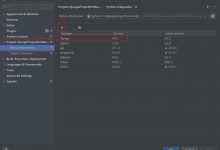机器学习——逻辑回归
Problem 1:如何理解coef_和intercept_两个模型参数
Solution 1:对于线性回归和逻辑回归,其目标函数为:f(x) =w0+w1x1+wxx2+…
如果有激活函数sigmoid,增加非线性变化,则为分类即逻辑回归;如果没有激活函数,则为线性回归。而对于coef_和intercept两个模型参数,常做如下用法
lr = LogisticRegression()lr.coef_ #除w0外的其余wilr.intercept_ #w0
Problem 2:如何利用matplotlib库绘制散点图
Solution 2:常调用scatter()函数,具体使用方法及参数说明参见:https://blog.csdn.net/xiaobaicai4552/article/details/79065990
补充:scatter()函数 c(color)参数的使用:以上述代码为例:设置c = y_label,而y_label有两类值即0/1,且与x_label中的数对相对应,也就是说一对一的逻辑关系,用0/1两类值代表两类颜色来区分点。更一步说,只需要y_label中存在任意不相等的2对数即可,例如:
设置
y_label = np.array([1,1,1,2,2,2])
也可达到相同的区分效果
Problem 3:对于scatter()函数中x_features[:,0]和x_features[:,1]的设置不太清晰
Solution 3:x_features = np.array([[-1, -2], [-2, -1], [-3, -2], [1, 3], [2, 1], [3, 2]]) 即如图所示:
x_features[:,0]则代表二元数对中的第一元的集合,x_features[:,1]代表二元数对中的第二元的集合

Problem 4:对plt.xlim()和plt.ylim()理解模糊
Solution 4:xlim()/ylim()两函数的功能是设置x/y轴的数据显示范围,或者调用两函数来获取对应轴上数据的最大最小值(范围),使用方法如下(以设置x轴为例,y轴同理):
plt.xlim(xmin,xmax) #xmin为x轴上的最小值,xmax为x轴上的最大值xmin,xmax = plt.xlim()
Problem 5:不了解Numpy中的meshgrid()函数
Solution 5:从坐标向量中返回坐标矩阵,简而言之,就是一维向量和另一维向量之间的数进行组合(先后顺序不可颠倒),获得一个由二元数对组成的二维矩阵,返回两个数组(x/y)
参见:https://blog.csdn.net/littlehaes/article/details/83543459
Problem 6:不了解Numpy中的linspace()函数
Solution 6:该函数的功能是在指定的间隔内返回均匀间隔的数字
参见:https://blog.csdn.net/Dontla/article/details/98342415
Problem 7:predict_proba()和predict()两函数的作用和区别
Solution 7:参见:https://www.cnblogs.com/mrtop/p/10309083.html
Problem 8:Numpy中的np.c_[]和np.r_[]的作用和区别
Solution 8:两方法均用于连接矩阵,区别在于np.r_按行叠加矩阵,np.c_按列叠加矩阵
参见:https://blog.csdn.net/C_chuxin/article/details/84777481
Problem 9:Numpy中的扁平化函数ravel()的使用和拓展
Solution 9:Numpy提供了两个扁平化函数:ravel和flatten()函数,这两个函数实现的功能相同,但在内存上有一些差别
参见:https://www.cnblogs.com/mzct123/p/8659193.html
Problem 10:关于Numpy中的reshape()函数
Solution 10:reshape()函数的功能是在不改变矩阵数值的前提下修改矩阵的形状
可参见:https://blog.csdn.net/qq_28618765/article/details/78083895?utm_medium=distribute.pc_relevant.none-task-blog-BlogCommendFromMachineLearnPai2-1.add_param_isCf&depth_1-utm_source=distribute.pc_relevant.none-task-blog-BlogCommendFromMachineLearnPai2-1.add_param_isCf
拓展:Numpy中类似的还有tranpose()函数,关于tranpose()函数可参见:https://www.geek-share.com/detail/2725359244.html
Problem 11:关于plt.contour的理解应用及其相关拓展
Solution 11:参见两篇博客:https://www.cnblogs.com/nxf-rabbit75/p/10463093.html
https://www.geek-share.com/detail/2703920219.html
基于鸢尾花(iris)数据集的逻辑回归实践
Step 1:函数库导入
## 基础函数库import numpy as npimport pandas as pd## 绘图函数库import matplotlib.pyplot as pltimport seaborn as sns
Step 2:数据读取/载入
##利用sklearn中自带的iris数据作为数据载入,并利用Pandas转化为DataFrame格式from sklearn.datasets import load_irisdata = load_iris()iris_target = data.target #得到数据对应的标签,已经过处理,iris_target里的0/1/2分别代表三种类型的花iris_attributes = data.data #获取属性数据labels = data.feature_names #获取属性值##利用Pandas转化为DataFrame格式iris_features = pd.DataFrame(data=iris_attributes, columns=labels)

step 3:查看数据信息
iris_features.info() #利用info()查看数据的整体信息iris_features.head()##iris_features.tail()iris_features.describe()
step 4:数据可视化
## 合并标签和特征信息iris_all = iris_features.copy() #进行浅拷贝,防止对于原始数据的修改iris_all[\'target\'] = iris_target## 特征与标签组合的散点可视化sns.pairplot(data=iris_all,diag_kind=\'hist\', hue= \'target\')plt.show()

##绘制箱线图for col in iris_features.columns:sns.boxplot(x=\'target\', y=col, saturation=0.5,palette=\'pastel\', data=iris_all)plt.title(col)plt.show()




step 5:利用逻辑回归模型在二分类上进行训练和预测
##为了正确评估模型性能,将数据划分为训练集和测试集,并在训练集上训练模型,在测试集上验证模型性能。from sklearn.model_selection import train_test_split##选择其类别为0和1的样本(不包括类别为2的样本)iris_features_part=iris_features.iloc[:100]iris_target_part=iris_target[:100]##测试集大小为20%,80%/20%分x_train,x_test,y_train,y_test=train_test_split(iris_features_part,iris_target_part,test_size=0.2,random_state=2020)##从sklearn中导入逻辑回归模型from sklearn.linear_model import LogisticRegression##定义逻辑回归模型clf=LogisticRegression(random_state=0,solver=\'lbfgs\')##在训练集上训练逻辑回归模型clf.fit(x_train,y_train)##查看其对应的wprint(\'the weight of Logistic Regression:\',clf.coef_)##查看其对应的w0print(\'the intercept(w0) of Logistic Regression:\',clf.intercept_)##在训练集和测试集上分布利用训练好的模型进行预测train_predict=clf.predict(x_train)test_predict=clf.predict(x_test)
step 6:模型评估
from sklearn import metrics##利用accuracy(准确度)【预测正确的样本数目占总预测样本数目的比例】评估模型效果print(\'The accuracy of the Logistic Regression is:\',metrics.accuracy_score(y_train,train_predict))print(\'The accuracy of the Logistic Regression is:\',metrics.accuracy_score(y_test,test_predict))##查看混淆矩阵(预测值和真实值的各类情况统计矩阵)confusion_matrix_result=metrics.confusion_matrix(test_predict,y_test)print(\'The confusion matrix result:\\n\',confusion_matrix_result)##利用热力图对于结果进行可视化plt.figure(figsize=(8,6))sns.heatmap(confusion_matrix_result,annot=True,cmap=\'Blues\')plt.xlabel(\'Predictedlabels\')plt.ylabel(\'Truelabels\')plt.show()
step 7:利用逻辑回归模型在三分类(多分类)上进行训练和预测
##测试集大小为20%,80%/20%分x_train,x_test,y_train,y_test=train_test_split(iris_features,iris_target,test_size=0.2,random_state=2020)##定义逻辑回归模型clf=LogisticRegression(random_state=0,solver=\'lbfgs\')##在训练集上训练逻辑回归模型clf.fit(x_train,y_train)##查看其对应的wprint(\'the weight of Logistic Regression:\\n\',clf.coef_)##查看其对应的w0print(\'the intercept(w0) of Logistic Regression:\\n\',clf.intercept_)##由于这个是3分类,所有我们这里得到了三个逻辑回归模型的参数,其三个逻辑回归组合起来即可实现三分类##在训练集和测试集上分布利用训练好的模型进行预测train_predict=clf.predict(x_train)test_predict=clf.predict(x_test)##由于逻辑回归模型是概率预测模型(前文介绍的p=p(y=1|x,\\theta)),所有我们可以利用predict_proba函数预测其概率train_predict_proba=clf.predict_proba(x_train)test_predict_proba=clf.predict_proba(x_test)
step 8:模型评估
print(\'The test predict Probability of each class:\\n\',test_predict_proba)##其中第一列代表预测为0类的概率,第二列代表预测为1类的概率,第三列代表预测为2类的概率。##利用accuracy(准确度)【预测正确的样本数目占总预测样本数目的比例】评估模型效果print(\'The accuracy of the Logistic Regression is:\',metrics.accuracy_score(y_train,train_predict))print(\'The accuracy of the Logistic Regression is:\',metrics.accuracy_score(y_test,test_predict))##查看混淆矩阵confusion_matrix_result=metrics.confusion_matrix(test_predict,y_test)print(\'The confusion matrix result:\\n\',confusion_matrix_result)##利用热力图对于结果进行可视化plt.figure(figsize=(8,6))sns.heatmap(confusion_matrix_result,annot=True,cmap=\'Blues\')plt.xlabel(\'Predicted labels\')plt.ylabel(\'True labels\')plt.show()

代码参考:https://developer.aliyun.com/ai/scenario/9ad3416619b1423180f656d1c9ae44f7?spm=5176.12901015.0.i12901015.5589525csLKDtN
小结
关于逻辑回归算法的运用尚未学习透彻,一些知识点还未总结完,对于代码,不可仅仅停留在调库上,仅做一个调包侠。任重道远~~
 爱站程序员基地
爱站程序员基地


